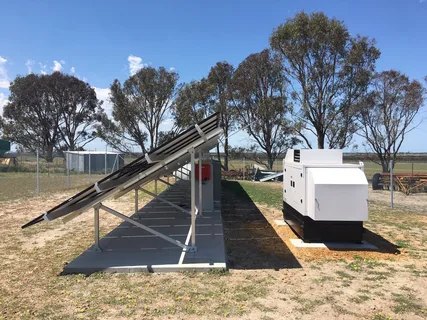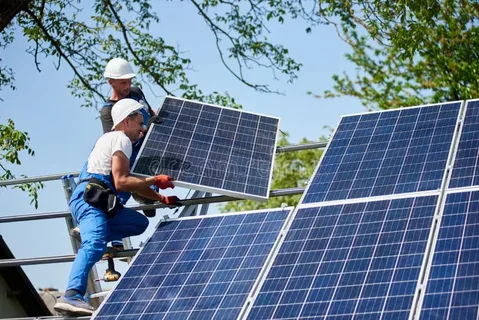Going green is becoming increasingly important in our modern world. Stand Alone Power Systems Australia (SAPSA) is an example of a company that is helping to lead the charge in creating sustainable solutions for powering homes and businesses. SAPSA offers a range of stand-alone, off-grid power systems designed to help reduce environmental impact and provide reliable, clean energy. In this blog post, we’ll be taking a closer look at what makes SAPSA so special and how they are helping to promote green energy solutions Down Under.
What are Stand-Alone Power Systems?
Stand-Alone Power Systems, also known as SAPS, are innovative and sustainable energy solutions that provide reliable power to homes and businesses. These systems operate independently from the traditional power grid, making them perfect for remote locations or areas with unreliable electricity supply.
At their core, SAPS consist of solar panels or wind turbines that generate clean energy. This energy is stored in batteries for later use, ensuring a constant power supply even when the sun isn’t shining or the wind isn’t blowing. The stored energy can then be converted into electricity using inverters, making it usable for all our daily needs.
What sets SAPS apart from traditional power systems is their ability to be entirely off-grid. They offer a more eco-friendly alternative to relying solely on fossil fuels for electricity. By harnessing renewable sources of energy, such as solar or wind power, SAPS reduce carbon emissions and help combat climate change.
Moreover, SAPS provide the freedom and independence to live in remote areas without compromising on modern amenities. They can be tailored to individual needs, from small residential systems to larger commercial setups. This flexibility makes them an ideal solution for those seeking reliable and sustainable energy, no matter their location.
Benefits of a Stand Alone Power
One of the major benefits of a Stand Alone Power is their ability to provide a reliable and uninterrupted power supply, no matter the location. This is particularly advantageous for remote areas or places with unreliable electricity supply. By relying on renewable energy sources like solar or wind power, SAPS offer a sustainable alternative to traditional power systems that depend on fossil fuels. This not only helps reduce carbon emissions and combat climate change but also promotes a cleaner and greener environment.
Another significant benefit of SAPS is their flexibility and adaptability. These systems can be customized to meet individual needs, whether it’s for a small residential setup or a large commercial operation. With the freedom to choose the size and capacity of the system, users have the power to generate the amount of electricity they require without wasting any excess energy. This efficiency not only saves money in the long run but also minimizes energy wastage and promotes sustainable practices.
SAPS also offer the advantage of energy independence. With a stand-alone system, users are not at the mercy of the traditional power grid and its associated limitations. Instead, they have the freedom to generate their own clean energy and be self-sufficient. This can be particularly beneficial during power outages or times of high demand when the grid may struggle to meet the needs of everyone. With SAPS, individuals and businesses can rely on a constant and uninterrupted power supply.
Furthermore, using SAPS can help reduce energy costs in the long run. While the initial investment may be higher than traditional power systems, the ongoing operational costs are significantly lower. Renewable energy sources like solar and wind power are free and abundant, meaning that once the system is installed, the cost of generating electricity becomes minimal. This can result in substantial savings over time, making SAPS a cost-effective solution for both homeowners and businesses.
Examples of Stand-Alone Power Systems
Australia is a vast and diverse country, making it an ideal location for implementing Stand-Alone Power Systems (SAPS). There are numerous examples of SAPS in Australia, each showcasing the incredible potential of sustainable and reliable energy solutions.
One notable example is the SA Water Solar Energy Project in South Australia. This initiative involved installing solar panels on several of SA Water’s treatment plants, helping to power the facilities and reduce their reliance on traditional energy sources. The project not only significantly reduced carbon emissions but also provided a reliable and cost-effective power source for the plants.
Another remarkable example is the Coober Pedy Renewable Hybrid Power Project. Coober Pedy, a remote town in South Australia, is known for its underground homes and lack of reliable power supply. The project aimed to address this issue by installing a hybrid system that combines solar energy with battery storage and diesel generation. This innovative system provides a consistent and clean power supply to the community, reducing their dependence on diesel generators and improving energy efficiency.
Additionally, the DeGrussa Solar Project in Western Australia is a shining example of a large-scale SAPS. This project consists of a 10.6-megawatt solar farm combined with a battery storage system. It provides a significant portion of the DeGrussa Copper-Gold Mine’s power needs, reducing their reliance on diesel and significantly reducing carbon emissions. The success of this project highlights the potential of SAPS for powering large industrial operations in a sustainable and cost-effective manner.
Challenges and Limitations of Stand Alone Power System Batteries
While Stand Alone Power batteries (SAPS) offer numerous benefits, it is important to also consider their challenges and limitations, particularly when it comes to the batteries used in these systems. One of the primary challenges is the cost of these batteries. The initial investment for SAPS can be quite high, and batteries can often be the most expensive component. However, it is important to remember that these costs are offset by long-term savings in energy costs and reduced environmental impact.
Another limitation of Stand-Alone power system batteries is their lifespan. Like all batteries, they have a limited lifespan and will eventually need to be replaced. This can add to the overall cost of maintaining the system. However, advancements in battery technology are constantly being made, and newer batteries have longer lifespans, making them a more viable option for SAPS.
Additionally, the storage capacity of Stand-Alone power system batteries can be a limitation. Depending on the size and capacity of the system, batteries may not be able to store enough energy to meet high energy demands or sustain prolonged periods of low sunlight or wind. This can result in a temporary reliance on alternative power sources or a need to reduce energy consumption during times when the system is not generating enough energy.
Lastly, the environmental impact of battery production and disposal is an important consideration. The manufacturing process of batteries can contribute to pollution and greenhouse gas emissions. Proper disposal and recycling of batteries is crucial to minimize their impact on the environment.
Tips for Choosing the Right Stand Alone Power Supply Systems for Your Needs
When it comes to choosing the right Stand Alone Power Supply Systems (SAPS) for your needs, there are a few important factors to consider. Here are some tips to help you make the right choice:
- Assess your energy needs: Start by evaluating your current and future energy needs. Consider the size of your home or business, the number of appliances you use, and your daily energy consumption. This will give you an idea of the capacity and size of the SAPS system you require.
- Research reputable providers: Take the time to research and compare different SAPS providers. Look for companies with a track record of delivering reliable and high-quality systems. Read customer reviews and ask for recommendations from friends or colleagues who have already installed SAPS.
- Consider your location: Your location plays a crucial role in determining the type of SAPS system that will work best for you. If you live in an area with abundant sunlight, a solar-based system might be the most suitable. On the other hand, if your location experiences high winds, a wind-based system could be a better choice.
- Determine your budget: Set a realistic budget for your SAPS system, considering both the initial installation costs and the long-term operational costs. Remember that while SAPS systems can be more expensive upfront, they often result in significant long-term savings.
- Consult with a professional: Consider consulting with a professional in the field who can provide expert advice and help design a SAPS system tailored to your specific needs. They can assess your energy requirements, evaluate your location, and recommend the most suitable system for you.
FAQs
Have some questions about Stand-Alone Power Systems (SAPS)? We’ve got you covered! Here are answers to some frequently asked questions:
1. Are SAPS systems reliable?
Absolutely! SAPS are designed to provide a reliable and uninterrupted power supply, no matter the location. By harnessing renewable energy sources like solar or wind power, SAPS offer a sustainable alternative to traditional power systems that depend on fossil fuels. This ensures a constant power supply, even in remote areas or during times of high demand.
2. Can SAPS save me money?
Yes, they can! While the initial investment may be higher than traditional power systems, the ongoing operational costs are significantly lower. Renewable energy sources like solar and wind power are free and abundant, meaning that once the system is installed, the cost of generating electricity becomes minimal. This can result in substantial savings over time.
3. Can SAPS be customized to my needs?
Absolutely! SAPS can be tailored to meet individual needs, whether it’s for a small residential setup or a large commercial operation. You have the freedom to choose the size and capacity of the system, allowing you to generate the amount of electricity you require without wasting any excess energy.
Conclusion
In a world where environmental sustainability is increasingly crucial, Stand-Alone Power Systems Australia (SAPSA) is at the forefront of providing innovative and reliable solutions for powering homes and businesses. SAPSA’s stand-alone, off-grid power systems offer a greener alternative to traditional power sources, harnessing renewable energy from solar panels and wind turbines. These systems provide a constant and uninterrupted power supply, making them ideal for remote areas or places with unreliable electricity grids.



